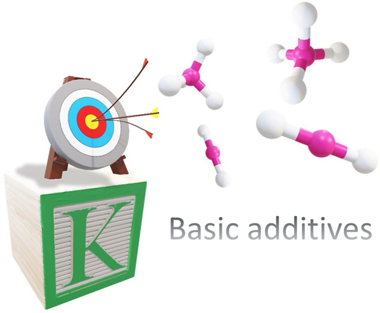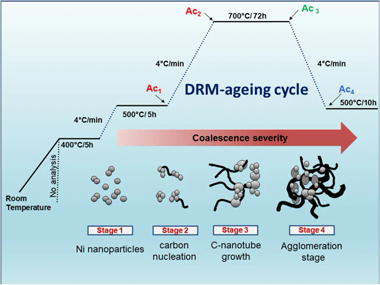Scientific Papers in SCI
2021
2021
Química de Superficies y Catálisis
Effect of potassium loading on basic properties of Ni/MgAl2O4 catalyst for CO2 reforming of methane
Azancot, L; Bobadilla, LF; Centeno, MA; Odriozola, JAJournal of CO2 Utilization, 52 (2021) 101681
Show abstract ▽

Coke deposition is one of the key issues in the dry reforming of methane on Ni catalysts. In the present work, we investigate the effect of potassium addition for suppressing carbon deposition in the Dry Reforming of Methane. The results obtained demonstrated that potassium contents above 3 wt% promote carbon gasification, favouring both Reverse Water Gas Shift and Boudouard reaction. Strong basic Mg-O-K sites are responsible for these reactions allowing the suppression of carbon deposits and allowing the stability of the catalyst.
October, 2021 | DOI: 10.1016/j.jcou.2021.101681
Tribología y Protección de Superficies
Nb-C thin films prepared by DC-MS and HiPIMS: Synthesis, structure, and tribomechanical properties
Sala, N; Abad, MD; Sánchez-López, JC; Caro, J; Colominas, CSurface & Coatings Technology, 422 (2021) 127569
Show abstract ▽

Nanostructured Nb-C thin films were prepared by direct current magnetron sputtering (DC-MS) and high-power impulse magnetron sputtering (HiPIMS). The films were characterized in depth by X-ray diffraction (XRD), grazing incidence X-ray diffraction, scanning electron microscopy, atomic force microscopy, electron probe microanalysis, and Raman spectroscopy. The mechanical properties were measured by nanoindentation, and the tribological properties were measured by pin-on-disk tests in ambient air. The wear tracks and ball scars were analyzed by Raman spectroscopy to elucidate the tribochemical reactions that occurred at the contact area and to determine the wear mechanism for each specimen type. The thermal stability of the coatings was studied up to 1000 degrees C using Raman spectroscopy and XRD. The samples prepared by DC-MS were very dense, and the phase composition changed from purely nanocrystalline (Nb2C and NbC) to a mixture of NbC crystals embedded in an amorphous carbon-based matrix (NbC/a-C(:H)). However, the samples prepared by HiPIMS developed a marked columnar morphology with a NbC/a-C(:H) nanocomposite structure. The hardness values ranged from 11 to 20 GPa depending on the deposition technique and the amount of the soft a-C(:H) phase present in the sample. The tribological properties of all the coatings were remarkably good when the carbon content was approximately 50 at.%. The formation of a lubricating sp(2)-rich C tribofilm between the ball and coating during the pin-on-disk tests was observed by Raman spectroscopy. The tribofilm formed preferentially on the samples prepared by HiPIMS, which had higher C contents. At 750 degrees C, the degradation of the NbC phases resulted in the formation of an additional a-C phase and niobium oxides.
September, 2021 | DOI: 10.1016/j.surfcoat.2021.127569
Materiales Coloidales
Si sputtering yield amplification: a study of the collisions cascade and species in the sputtering plasma
Cruz, J; Sangines, S; Soto-Valle; Muhl; Sierra, I; De Lucio-Morales, O; Mitrani, A; Calderon-Olvera, RM; Mendoza-Perez, R; Machorro-Mejia, RJournal of Physics D-Applied Physics, 54 (2021) 375201
Show abstract ▽
The sputtering yield amplification (SYA) is a phenomenon based on doping a sputtering target with atoms of higher atomic mass. This doping changes the depth and the direction of the collision cascade in the target surface promoting a higher ejection of target atoms. In this work, we present a new way of generating the SYA phenomenon without the need of expensive and complex deposition systems. This was accomplished by increasing the working pressure and adding small pieces of W, as dopant element, on the racetrack of a Si target. The physical phenomena necessary to promote the SYA, for our experimental parameters, were analysed in two different deposition chambers and two sizes of sputtering targets. Based on the collisions in the gas phase, a calculation on the number of W atoms returning to the racetrack area was made, considering the number of atoms deposited on the thin films, to determine their effect on the cascade of collisions. In addition, calculations with the simulation of metal transport code were developed to determine the location on the racetrack zone the returning atoms were redeposited. By using reference samples placed on the racetrack of the Si target, we found that the percentage of SYA depends on the number of dopant atoms redeposited as well as the depth distribution these atoms had in the racetrack surface.
September, 2021 | DOI: 10.1088/1361-6463/ac0c4e
Materiales Nanoestructurados y Microestructura
Pd-C Catalytic Thin Films Prepared by Magnetron Sputtering for the Decomposition of Formic Acid
Arzac, GM; Fernandez, A; Godinho, V; Hufschmidt, D; de Haro, MCJ; Medran, B; Montes, ONanomaterials, 11 (2021) 2326
Show abstract ▽
Formic acid is an advantageous liquid organic hydrogen carrier. It is relatively nontoxic and can be synthesized by the reaction of CO2 with sustainable hydrogen or by biomass decomposition. As an alternative to more widely studied powdery catalysts, supported Pd-C catalytic thin films with controlled nanostructure and compositions were newly prepared in this work by magnetron sputtering on structured supports and tested for the formic acid decomposition reaction. A two-magnetron configuration (carbon and tailored Pd-C targets) was used to achieve a reduction in Pd consumption and high catalyst surface roughness and dispersion by increasing the carbon content. Activity and durability tests were carried out for the gas phase formic acid decomposition reaction on SiC foam monoliths coated with the Pd-C films and the effects of column width, surface roughness and thermal pre-reduction time were investigated. Activity of 5.04 mol(H2)center dot g(Pd)(-1)center dot h(-1) and 92% selectivity to the dehydrogenation reaction were achieved at 300 degrees C for the catalyst with a lower column width and higher carbon content and surface roughness. It was also found that deactivation occurs when Pd is sintered due to the elimination of carbon and/or the segregation and agglomeration of Pd upon cycling. Magnetron sputtering deposition appears as a promising and scalable route for the one-step preparation of Pd-C catalytic films by overcoming the different deposition characteristics of Pd and C with an appropriate experimental design.
September, 2021 | DOI: 10.3390/nano11092326
Materiales y Procesos Catalíticos de Interés Ambiental y Energético
Examination of the Deactivation Cycle of NiAl- and NiMgAl-Hydrotalcite Derived Catalysts in the Dry Reforming of Methane
Abdelsadek, Z.; Holgado, J.P.; Halliche, D.; Caballero, A.; Cherifi, O.; Gonzalez-Cortes, S.; Masset, P.J.Catalysis Letters, 151 (2021) 2696-2715
Show abstract ▽

The importance of the dry reforming of methane (DRM) lies in its capability to upgrade two greenhouse gases (CH4 and CO2) into synthesis gas (CO and H-2), which is one of the main building block for synthesizing hydrocarbons. However, the Ni-based catalysts for DRM reaction usually have a major catalytic stability drawback. This works aims to assess the catalytic activity and stability of two Ni-based catalysts obtained from hydrotalcite (HT) precursors (i.e., NiAl-HT and NiMgAl-HT). The precursors, calcined (-c), reduced (-R) and spent samples were characterized by a series of techniques to gain insight into the influence of MgO over Ni-based catalyst in the drying reforming of methane. An in-situ ageing cycle process to speed up the deactivation of hydrotalcite-derived catalysts showed that the NiMgAl-HTc-R catalyst displayed a higher activity and resistance to coke formation (stability) than NiAl-HTc-R because of the introduction of Mg into hydrotalcite structure in the catalyst precursor. The presence of this element enhances several factors involved in the stability of Ni-based catalysts for the DRM process such as the reducibility and textural features of the catalysts, size and dispersion of Ni-0 nanoparticles and also maintains a good compromise between the acid and base properties of the solid catalysts.
September, 2021 | DOI: 10.1007/s10562-020-03513-4
- ‹ previous
- 68 of 410
- next ›














